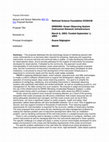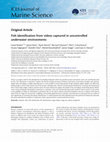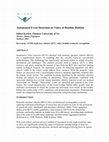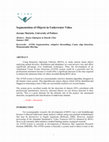Papers by Duane Edgington
This report addresses the problem of visual event c lassification. To do that we use a set of loc... more This report addresses the problem of visual event c lassification. To do that we use a set of local descriptors invariant to rotation and scale. Each image is described by one feature vector. First, a set of invariant descriptors with respect to rotation and shift are computed for each pixel at different space scales. Then, thr ough nonlinear operations, they are mapped to a higher dimensional space, where they ar e averaged. Fisher’s Linear Discriminants are used to reduce the dimensionality of the feature vectors representing each image. Then the feature vectors distributions, for each class of events, are modeled using Mixtures of Gaussians. Differently from previ ous approaches, we take also color information into account when computing the feature vectors.

This proposal addresses the key technology issues of interfacing sensors with ocean observatories... more This proposal addresses the key technology issues of interfacing sensors with ocean observatories to a) decrease labor required for preparing, deploying and supporting instruments, b) ensure real-time and archived data is usable, c) make developing instruments for observatories easier, and d) provide pathways for the support of instruments not purposedeveloped for observatories. If adopted by the community, this approach would allow interoperability of instruments between ocean observatories. The testing program proposed here, and the involvement of instrument manufacturers and observatory developers at other institutions, is structured to ensure that development of the instrument infrastructure is responsive to community needs and the results made widely available. MBARI is applying distributed object, smart network, plug-and-work, and XML technologies to create a uniform software infrastructure to support the development, deployment, and operation of mooring based, deep ocean observing systems. Our goal is to simplify the problems of configuring, interfacing, and controlling instruments in networked observing systems with potentially intermittent and limited bandwidth, as well as simplifying access to, and management of, the data coming from such systems. We propose to adapt and prototype test the use of this infrastructure for MARS (Monterey Accelerated Research System), a cable based system being used to prototype a regional scale cable observing (RSCO) system. Ocean observing systems have received increasing attention as a result of the growing recognition that ocean processes are still poorly understood, that oceans resources are not being adequately assessed and managed, and that ocean events such as the El Nino phenomena, can have a significant impact on public property, health and safety. Next generation cabled observatories will have bandwidths between 10s or even 100s of gigabits per second, and may support hundred or thousands of instruments. Thus reducing support requirements for instrumentation is essential for the economic viability of observatory facilities. The work proposed here would solve the key interfacing and data management problems by making the interface problem part of instrument development rather than an installation problem, and by handling commercial off the self instruments in a straightforward easy manner. There is now a pressing need to develop a uniform infrastructure to configure, interface, and control instruments as well as managing data from the instruments deployed in these systems. The specific challenge is to adapt and apply a variety of proven technologies developed for land based environments to the unique and demanding requirements of the ocean environment. The specific problem addressed is how well does the infrastructure being developed for deep-ocean mooring based systems work for near shore, high-bandwidth, cable based systems. Intellectual merit-This proposal addresses three main problems: 1) developing a standard instrument interface protocol and instrument adaptor (puck) that will simplify ease of configuration at sea, as well as automated device and service discovery in the system, 2) development of a standard methodology for describing instrument metadata, using XML technology, and a means for delivering sensor data, along with its metadata, to shore, and 3) a uniform application programming interface (API) using distributed object, client-server technology, that will simplify the task of controlling and accessing instruments by making the network layer transparent to the application developer. This will be a major step forward in bringing the benefits of current technology to ocean observing systems. We are making use of the tools, techniques, and products being developed by industry to address distributed computing networks of devices, and re-targeting them to the problems of a variety of ocean observatories. Broader impacts-The products of this proposal will enable a lower cost of entry of a broad range of investigator's sensors in a variety of ocean observing systems and reliable collection of information (data and metadata) from sensors in those systems. These products will enable cost-effective collection of integrated, multidisciplinary data relevant to critical issues, such as ocean modeling and prediction, the climate system, the carbon cycle, natural hazards, littoral and deep water sensing, and biological processes in the ocean.
Ocean observing systems may include a wide variety of sensor and instrument types, each with its ... more Ocean observing systems may include a wide variety of sensor and instrument types, each with its own capabilities, communication protocols and data formats. Connecting disparate devices into a network typically requires specialized software drivers that trans
OCEANS 2011 IEEE - Spain, 2011
Page 1. Interoperable Data Management and Instrument Control Experiences at OBSEA Joaquin del Rio... more Page 1. Interoperable Data Management and Instrument Control Experiences at OBSEA Joaquin del Rio1, Daniel Mihai Toma1, Thomas C. O'reilly2, Arne H. Bröring3, Antoni Manuel1, Kent L. Headley2, Duane Edgington2 1Technical ...
2008 IEEE Fourth International Conference on eScience, 2008
We are designing and prototyping a generalized observatory middleware framework (OMF) to integrat... more We are designing and prototyping a generalized observatory middleware framework (OMF) to integrate existing and proposed technologies and reduce duplication of functionality across observatories. Our implementation consists of an enterprise service bus (ESB) architecture capable of integrating a wide variety of message-based technologies, a security proxy (SP) that uses X.509 credentials to sign and verify messages to and from the

The need to change the focus in science education from an emphasis on students learning just the ... more The need to change the focus in science education from an emphasis on students learning just the facts to one where students develop an understanding and use of science inquiry is critical for a science literate society (Project 2016, AAAS). Using real-time and near – real-time data in the classroom can bridge this discrepancy by exposing students to process of science based upon scientifically collected data. This allows the classroom to be a synthesis of scientific knowledge and scientific sociology which leads to a scientific understanding of the world (Project 2016, AAAS). This project blends uploaded video footage captured by the Eye-in-the-Sea, narration from the actual scientists and the ability of students to also comment and question with a tool that’s available to anyone with internet access. VoiceThread, the on-line application, facilitates interactive sharing to increase excitement about scientific inquiry of the deep sea for today’s students. The multiple VoiceThreads p...
Informational Resources 7 (IR) management is a crucial part of environmental resources management... more Informational Resources 7 (IR) management is a crucial part of environmental resources management. Indeed, the improvement of data processing and decision-making is strongly related to the ability to
Informational Resources 7 (IR) management is a crucial part of environmental resources management... more Informational Resources 7 (IR) management is a crucial part of environmental resources management. Indeed, the improvement of data processing and decision-making is strongly related to the ability to
Environmental Science & Technology
Consiglio per la ricerca in agricoltura e l'analisi dell'economia agraria (CREA-IT),

ICES Journal of Marine Science: Journal du Conseil, 2016
There is an urgent need for the development of sampling techniques which can provide accurate and... more There is an urgent need for the development of sampling techniques which can provide accurate and precise count, size, and biomass data for fish. This information is essential to support the decision-making processes of fisheries and marine conservation managers and scientists. Digital video technology is rapidly improving, and it is now possible to record long periods of high resolution digital imagery cost effectively, making single or stereo-video systems one of the primary sampling tools. However, manual species identification, counting, and measuring of fish in stereo-video images is labour intensive and is the major disincentive against the uptake of this technology. Automating species identification using technologies developed by researchers in computer vision and machine learning would transform marine science. In this article, a new paradigm of image set classification is presented that can be used to achieve improved recognition rates for a number of fish species. State-of-the-art image set construction, modelling, and matching algorithms from computer vision literature are discussed with an analysis of their application for automatic fish species identification. It is demonstrated that these algorithms have the potential of solving the automatic fish species identification problem in underwater videos captured within unconstrained environments.
We demonstrate an attentional selection system for processing video streams from remotely operate... more We demonstrate an attentional selection system for processing video streams from remotely operated underwater vehicles (ROVs). The system identifies potentially interesting visual events spanning multiple frames based on low-level spatial properties of salient tokens, which are associated with those events and tracked over time. If video frames contain interesting frames, they are labeled "interesting", otherwise they are labeled "boring". By marking the interesting events and omitting boring frames in the output stream, we augment the productivity of human video annotators, or, alternatively, provide input for a subsequent object classification algorithm.
Oceans 2009, Oct 1, 2009
The time-study data collected at the Station M site off the coast of central California includes ... more The time-study data collected at the Station M site off the coast of central California includes high quality still-frame images taken in 1-hour time-lapse increments. The approximately 67,000 time-lapse images collected would take an unfeasible amount of time to fully analyze manually, and therefore would benefit from automated analysis. Towards this end, this work is an aid in the significant effort to analyze megafaunal activity and sedimentation events using an adapted version of the Automated Video Event Detection and Classification System (AVEDac) formerly designed by MBARI to analyze video collected from MBARI's remotely operated underwater vehicles (ROVs) video. This paper describes, in general, the automated system that will aid in the abundance and distribution studies of animals at the Station M site.
Many sensor networks have been deployed to monitor Earth&... more Many sensor networks have been deployed to monitor Earth's environment, and more are planned for the future. Environmental sensors have continuously improved by becoming smaller, cheaper, more intelligent, and more reliable. But due to the large number of sensor manufacturers and accompanying protocols, integrating diverse sensors into observing systems is not straightforward, requiring development of driver software and manual tedious

Quantitative video transects (QVTs) obtained with remotely operated vehicles (ROVs) are a sophist... more Quantitative video transects (QVTs) obtained with remotely operated vehicles (ROVs) are a sophisticated means of sampling that has recently replaced conventional methodologies. This technology has significantly advanced studies in animal diversity, distribution and abundance. The method currently used to analyse QVTs is labor intensive and costly, reducing the amount of data from the ROV dive and thus limiting marine ecological research. An automated system for detecting organisms and other objects visible in the videos would address these concerns. With this program, video frames are processed with a neuromorphic-selective attention algorithm, modeled after the human vision system. The candidate locations identified by the attention selection module are subject to a number of parameters. These parameters combined with successful tracking over several frames determine whether detected events are deemed "interesting" or "boring". "Interesting" events are...

Using Remotely Operated Vehicles (ROVs) to study marine fauna allows analyzing animal diversity, ... more Using Remotely Operated Vehicles (ROVs) to study marine fauna allows analyzing animal diversity, distribution and abundance in a non-invasive way and offers significant advantage over traditional techniques. Thus, the development of an Automated Visual Events Detection (AVED) system could be a powerful tool for professional annotators because it would offer a significant decrease in the time required to analyze the numerous hours of videos recorded during ROVs dives. The AVED system is based on a neuromorphic-selective attention algorithm, designed on the human vision system. This algorithm pre-selects objects which will be identified and flagged as interesting events if they are successfully tracked over several frames. The system gives excellent results for the detection of objects (92% correlation with professional annotations); however, detected objects are not always detected in their entirity. This is a great obstacle for the ultimate aim of the project: the automated detection, recognition and classification of underwater animals. … results + discussion

Uploads
Papers by Duane Edgington